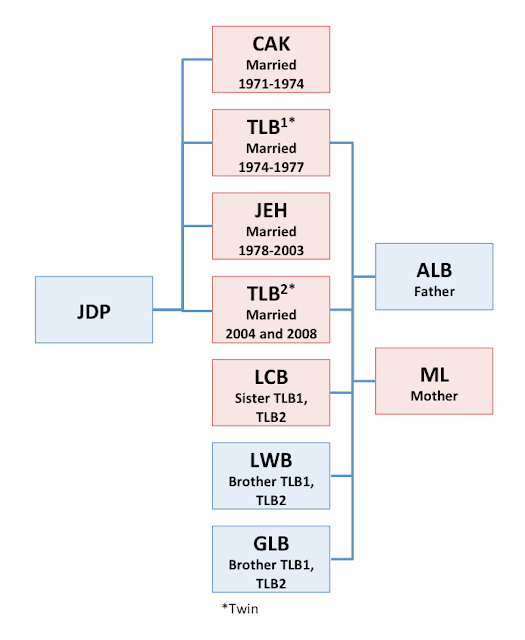James Lively was born on 6 August 1867 at 112 Poker Row in the Old Monklands Parish of Lanarkshire, Scotland. His parents were James Lively, a collier, and Marion Sneddon. Young James' father died of scarlet fever when he was four years old.
By the time James was 13, he lived in Blantyre with his widowed mother and three siblings. He was already working as a miner in the coal pit. He married Elizabeth Brodie Muir, my second cousin twice removed, on 31 December 1891 in Blantyre. The last day of the year was popular day for marriages as New Year's Day was a holiday in the mines. Couples and their families had more time to celebrate before the new husband had to go back to work.
 |
| Dixon's Rows, Blantyre, Scotland; photograph courtesy of Auld Blantyre Mining |
- Henrietta Cassels Lively, born 1892; died 11948; married Alexander Paterson
- James Lively, born 1893; died 1894
- James Lively, born 1896; died 1971; possible marriage information unknown
- William Lively, born 1899; died 1918
- John Sneddon Lively, born 1902; died 1983; possible marriage information unknown
- Marion Sneddon Lively, born 1905; died 1982; married David Gibson
A Series of tragedies
James and Elizabeth lost their second child, son James, on 26 February 1894 to congestion of the lungs. He was just three months old. They named their next child James, too, after his paternal grandfather and father as was the custom at the time.In the early morning hours of the night 23-24 June 1906, Elizabeth's husband, James, died of chest injuries after being accidentally knocked down and run over by two horses attached to a lorry in Glasgow Road. He was carried home and survived five hours. His wife was left a widow at the age of 32. She had five children ranging in age from 14 to a year old.
Elizabeth Muir (Brodie) died on 14 June 1910 at her sister's house of pulmonary phthisis, or tuberculosis. Her nephew, James Moore, died on the same day in the same house of accute broncho pneumonia. The hour of their deaths were recorded by the certifying physician as being at the same time. Elizabeth's occupation was listed as "pauper" on her death registration, so life cannot have been easy for she and her children after James died four years previously.
What happened to the children?
As soon as I learned those five children had been left orphaned at such young ages, I wanted to find out what happened to them; but I bumped up against the 100-year British privacy law. The 1911 census is the most recent census available to the public. I discovered two of the boys -- James and William -- lived with their paternal grandfather and his second wife in 1911. I was not able to find the rest of the children in that census.Henrietta Cassels Lively
The oldest daughter, Henrietta Cassels Lively, married in 1912. I had no problem researching her family until I bumped into the same privacy law regarding the birth dates of possible children. The surname Paterson was quite common so I could only surmise Henrietta and Alexander had two children, those born earlier enough I could view their birth registrations on ScotlandsPeople and verify the names of their parents. My recent contact through Ancestry alerted me to another child and gave me the information about how she was related to her.
James Lively
James Lively remains my big outstanding mystery about this family. I now know through my contact via my Robert Muir Family blog that he and brothers, William and John Sneddon, were sent to England to work. I know from the UK, Army Registers of Soldiers Effects, 1901-1929, Henrietta (Lively) Paterson, James and John Sneddon Lively received William's back pay and a war gratuity after his death. James died sometime between October and December 1971 in Blackburn, Lancashire, England.
William Lively
I also found William Lively had gone to Blackburn, Lancashire, England, though at the time I had no idea why. He was drafted by the 1/4 East Yorkshire Regiment. William was killed in action in near Soissons, France, when his unit was decimated during the Third Battle of Aisne. His name was included on the Soissons Memorial but was not listed on the World War I memorial in Blantyre, which I think is a shame.
 |
| Soissons Memorial; photograph courtesy of the Commonwealth Graves Commission |
John Sneddon Lively
I had found a death index record for John Sneddon Lively. He died sometime between July and September 1983 in Blackburn, Lancashire, England. I do not know if he married or the names of any possible children.
Marion Sneddon Lively
Since I wrote about the family of James and Elizabeth Muir (Brodie) Lively, I learned they had a daughter named Marion Sneddon Lively who was born in 1905. Yet I had not researched her any further. My blog contact told me Marion had been adopted and her name was changed to May Hawkins. Using several combinations of names on ScotlandsPeople, I was able to find her birth, death and marriage registrations as well as the Hawkins family in the 1911 census.
Marion had been adopted by John and Rachel Hawkins and was listed in the 1911 census as Mowin Lively. She married David Gibson in 1928 and died 1982. Perhaps never leaving the town of her birth. I learned from my Ancestry contact that Marion Sneddon (Lively) Gibson raised her grand niece, Elizabeth Morrison, due to postnatal complications. So the family tragedies continued.
_______________
From Tragedy to Tragedy
Soissons Memorial
Killed During the Spring Offensive
Dixon's Rows: "A Most Miserable Type of House"


























